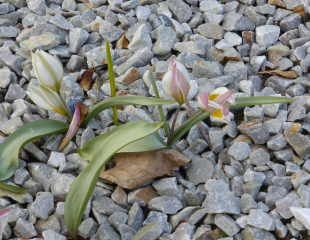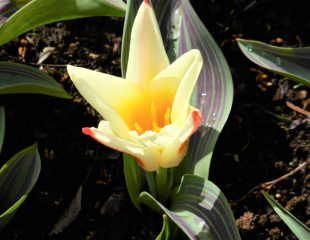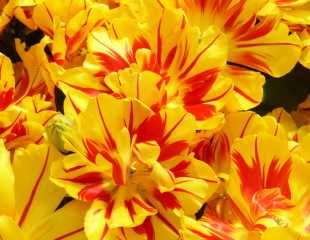How to pick Tulips which flower again


Many Tulips bulbs we buy are not perennial, which means they do not flower well, or at all the following year.
The original source of the wild form of Tulip came from Central Asia and the Caucasus region, along with Afghanistan, Jordan, and Kurdista. Tulip polychroma, illustrated left above. These are small Tulips, with unimpressive flowers are the origin of the complex flowers we grow today.
Most Tulips bulbs are sold as bedding, and with the cut flower market in mind, to be treated as annuals. Unless they are specific varieties identified as perennial, it is not worth the time and trouble of trying to coax them into weedy flowers for next year. Dig them up and compost.
There are a few varieties of Tulips which do flower again the next year. If you want a more permanent display, check out any of the varieties listed below, which are billed as perennial Tulips.
Repeat Flowering Perennial Tulips

Varieties of tulip that are repeat-flowering.
1. Suttons sells a great variety of Tulip called "Everlasting mixed" voted best in class for perennial tulip. It is specifically a perennial in lovely bold bright colours, and currently on offer from £9.99 - click here for details (affiliate link)
2. Tulip Lady Jane is a low growing tulip, up to .5m and perennial. Ideal for front of borders, rockeries and it is one of the few tulips which will naturalise well.

3. There is a group of Tulips called Darwin varieties, and many, but not all, are perennial. Darwin varieties are good for subsequent flowering varieties such as Apeldoorn’s Elite, ' Golden Apeldoorn' a very reliable bright yellow; tulip Burning Heart a red and white variety; Red Apeldoorn bright red; Mystic van Eijk a lovely soft pink and apricot; and Golden Parade award winning and, as you might expect, very yellow.
Illustrated is Olympic Flame, a really strong bright yellow and red. By crossing Darwin tulips with early fosteriana tulips, breeders developed Olympic Flame, a spectacular perennial tulip. Available from Crocus (affiliate link)

4. The group of tulips known as Lily-flowered are good repeat performers and come in a wide range of colours. These tulips are flute shaped.
Illustrated here is one of the most popular orange 'Ballerina' which is also scented. It grows to around .5m and looks good with wallflowers and for get me nots.
Crocus has a stunning selection of Lily Tulips including 'Ballerina' orange. (affiliate link)
Tips for growing tulips as Perennials
If you are growing Tulips as perennials, it is worth giving them extra attention:-Tips are:
1. Water well if the spring is dry
2. Feed Tulips during the growing season every two weeks
3. Deadhead the flower at the top of the stem so the bulb puts its energy into the bulb for next year, not the seed
4. Don't disturb the leaves until the tulip has completely died back.
5. Plant bulbs deeper than usual, about 4x plus the bulb size. After flowering dead head, and leave the foliage to die down naturally and they will (probably) be back next year.
